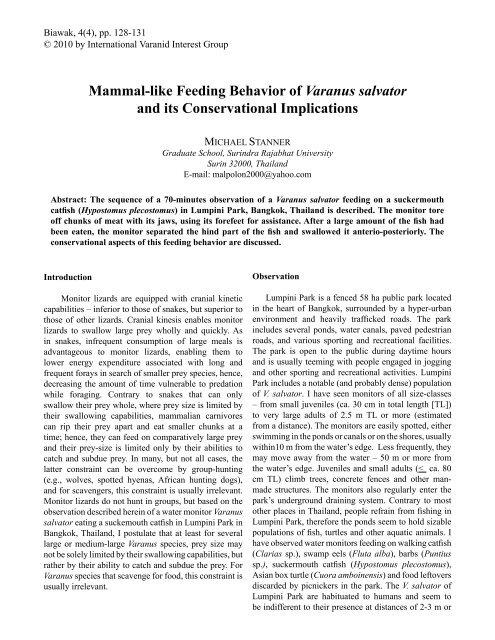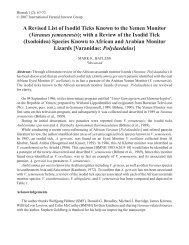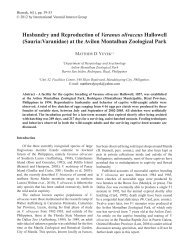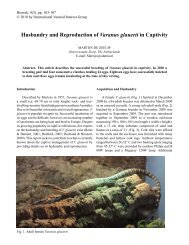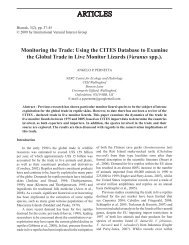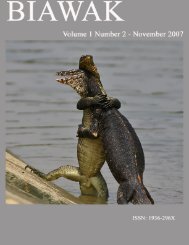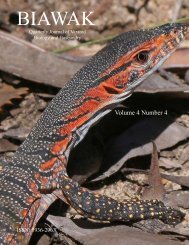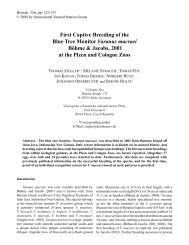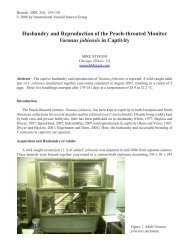BIAWAK - International Varanid Interest Group
BIAWAK - International Varanid Interest Group
BIAWAK - International Varanid Interest Group
- No tags were found...
Create successful ePaper yourself
Turn your PDF publications into a flip-book with our unique Google optimized e-Paper software.
Biawak, 4(4), pp. 128-131<br />
© 2010 by <strong>International</strong> <strong>Varanid</strong> <strong>Interest</strong> <strong>Group</strong><br />
Mammal-like Feeding Behavior of Varanus salvator<br />
and its Conservational Implications<br />
MICHAEL STANNER<br />
Graduate School, Surindra Rajabhat University<br />
Surin 32000, Thailand<br />
E-mail: malpolon2000@yahoo.com<br />
Abstract: The sequence of a 70-minutes observation of a Varanus salvator feeding on a suckermouth<br />
catfish (Hypostomus plecostomus) in Lumpini Park, Bangkok, Thailand is described. The monitor tore<br />
off chunks of meat with its jaws, using its forefeet for assistance. After a large amount of the fish had<br />
been eaten, the monitor separated the hind part of the fish and swallowed it anterio-posteriorly. The<br />
conservational aspects of this feeding behavior are discussed.<br />
Introduction<br />
Monitor lizards are equipped with cranial kinetic<br />
capabilities – inferior to those of snakes, but superior to<br />
those of other lizards. Cranial kinesis enables monitor<br />
lizards to swallow large prey wholly and quickly. As<br />
in snakes, infrequent consumption of large meals is<br />
advantageous to monitor lizards, enabling them to<br />
lower energy expenditure associated with long and<br />
frequent forays in search of smaller prey species, hence,<br />
decreasing the amount of time vulnerable to predation<br />
while foraging. Contrary to snakes that can only<br />
swallow their prey whole, where prey size is limited by<br />
their swallowing capabilities, mammalian carnivores<br />
can rip their prey apart and eat smaller chunks at a<br />
time; hence, they can feed on comparatively large prey<br />
and their prey-size is limited only by their abilities to<br />
catch and subdue prey. In many, but not all cases, the<br />
latter constraint can be overcome by group-hunting<br />
(e.g., wolves, spotted hyenas, African hunting dogs),<br />
and for scavengers, this constraint is usually irrelevant.<br />
Monitor lizards do not hunt in groups, but based on the<br />
observation described herein of a water monitor Varanus<br />
salvator eating a suckemouth catfish in Lumpini Park in<br />
Bangkok, Thailand, I postulate that at least for several<br />
large or medium-large Varanus species, prey size may<br />
not be solely limited by their swallowing capabilities, but<br />
rather by their ability to catch and subdue the prey. For<br />
Varanus species that scavenge for food, this constraint is<br />
usually irrelevant.<br />
Observation<br />
Lumpini Park is a fenced 58 ha public park located<br />
in the heart of Bangkok, surrounded by a hyper-urban<br />
environment and heavily trafficked roads. The park<br />
includes several ponds, water canals, paved pedestrian<br />
roads, and various sporting and recreational facilities.<br />
The park is open to the public during daytime hours<br />
and is usually teeming with people engaged in jogging<br />
and other sporting and recreational activities. Lumpini<br />
Park includes a notable (and probably dense) population<br />
of V. salvator. I have seen monitors of all size-classes<br />
– from small juveniles (ca. 30 cm in total length [TL])<br />
to very large adults of 2.5 m TL or more (estimated<br />
from a distance). The monitors are easily spotted, either<br />
swimming in the ponds or canals or on the shores, usually<br />
within10 m from the water’s edge. Less frequently, they<br />
may move away from the water – 50 m or more from<br />
the water’s edge. Juveniles and small adults (< ca. 80<br />
cm TL) climb trees, concrete fences and other manmade<br />
structures. The monitors also regularly enter the<br />
park’s underground draining system. Contrary to most<br />
other places in Thailand, people refrain from fishing in<br />
Lumpini Park, therefore the ponds seem to hold sizable<br />
populations of fish, turtles and other aquatic animals. I<br />
have observed water monitors feeding on walking catfish<br />
(Clarias sp.), swamp eels (Fluta alba), barbs (Puntius<br />
sp.), suckermouth catfish (Hypostomus plecostomus),<br />
Asian box turtle (Cuora amboinensis) and food leftovers<br />
discarded by picnickers in the park. The V. salvator of<br />
Lumpini Park are habituated to humans and seem to<br />
be indifferent to their presence at distances of 2-3 m or


